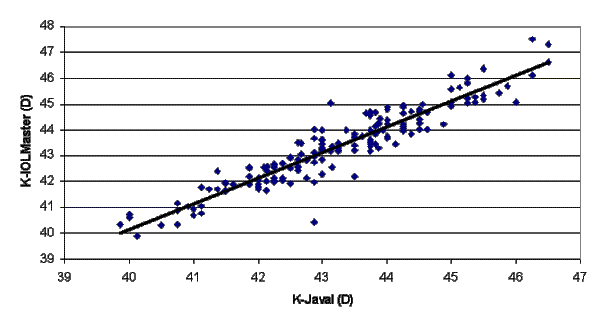János Németh:
Tear film and IOLMaster measurements
Dear Editor,
I read with great interest the recent
article of K. Sander & W. Bissmann and also that of M. Rütz, both on the
reproducibility of keratometry performed using the IOLMaster instrument.
Our own
experiences confirm the reported high precision of IOLMaster corneal power
measurements. In our comparative study (1) we found that the corneal refractive
power measurements of a Javal-type keratometer and those from the IOLMaster
were highly correlated (included one eye for each individual, r = 0.955; p <
0.001), with a mean difference of only 0.17 diopters. This difference, although
statistically significant (p < 0.001), is unimportant clinically.

Figure 1.
Correlation between the corneal power (K) measured by Javal type keratometer
and by the IOLMaster (both eyes included, r=0.936, p<0.001).
The other
interesting point is the possible effect of tear-film alterations on the
keratometric measurements. These two ULIB articles showed that there is no need
for artificial tear drops before performing IOLMaster keratometry, and indeed
that without tear drops the measurements seem to be more accurate. It would
however be very interesting to examine with the IOLMaster another important
aspect relating to the tear film, namely whether the elapsed time since the last
blink has any significant effect on the measured keratometric values.
The tear
film is not a stable structure, and it alters rapidly during the interval
between two successive blinks. At the end of a blink, as the upper lid moves
upwards it spreads the tear film over the exposed corneal and conjunctival
surface. But after the lid becomes stationary, the tears still move rapidly
upwards during a period of about 1 second; and even after this an extra 2-6
seconds are needed for the tear film to attain its most regular surface. In a
recent publication (2), we have described this phenomenon and named it the
"tear film build-up process". At a later time (around 10 seconds
after blinking, in healthy eyes), the well known tear film break-up starts to occur.
I would like
to call attention to our findings that in the case of corneal topographic
measurements, the length of the elapsed time since the last blink significantly
influenced the surface regularity indices, because of the above mentioned rapid
build-up changes in the tear film (although we found no significant effect on
the simulated keratometric values).
We have
published two articles providing evidence of significant tear film alterations
just after blinking in the inter-blink period (2,3). We have suggested that it
is desirable to try to optimise the time point at which corneal topography
measurements are made. It would appear that the optimum time for measurement
might be the time period after the end of the tear film build-up process (2)
but before the tear film break-up starts, i.e. measurements should be made
typically between ca. 3-7 seconds after the last blink (3).
I believe
that such tear-film alterations might influence IOLMaster keratometry as well,
and therefore it may be important to examine the effect of such alterations on
IOLMaster keratometric readings during the different phases of the interblink
period.
Congratulations
on the very useful and interesting ULIB published articles.
Best regards
Prof. János Németh MD, PhD
1st Dept. of Ophthalmology
Semmelweis University
Tömő u. 25-29.
H-1083 Budapest, Hungary
Tel: + 36 30 952-3310
Fax: + 36 1 303-8974
email: nj@szem1.sote.hu
Literature:
(1) Németh J., Fekete O., Pesztenlehrer N.: Comparison
of optical and ultrasound measurement of axial eye length and anterior chamber
depth for intraocular lens power calculation. J Cataract Refract Surg 29:
85-88, 2003 (2) Németh J., Erdélyi B., Csákány B., Kahlesz F.,
Gáspár P., Lang Zs.: High-speed video topographic measurement of tear film
build-up time. Invest Ophthalmol Vis Sci 43: 1783-1790, 2002. (3) Németh J., Erdélyi B., Csákány B.: Corneal
topography changes after a 15 second pause in blinking. J Cataract Refract Surg 27: 589-592,
2001.
For copies of the above articles please contact the author via
nj@szem1.sote.hu.